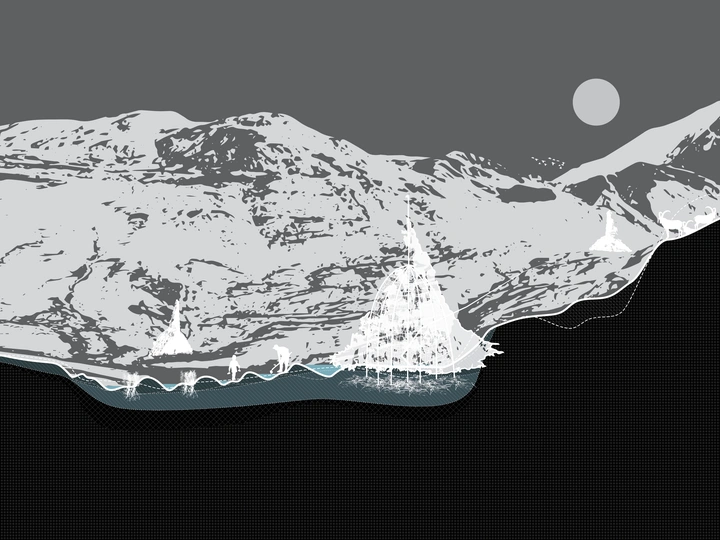The Alpine Ocean

Emilie Stecher is an urbanist, designer, writer, storyteller, cartographer, and artist.
Currently, she is working as a researcher and lecturer at the Institute of Landscape Architecture at BOKU University of Natural Resources and Life Sciences in Vienna and as an exhibition designer in their family-run studio. She acquired a masters in Urbanism from Delft University of Technology (distinction) in the graduation studio Transitional Territories and a bachelor in Architecture from the University of Liechtenstein (great success) as the first University graduate in her family. She is a board member of the Club Alpbach Vorarlberg, representing a network of young, politically engaged people to rethink the future of Europe in a changing world.
In her work she focuses on a nexus between culture, ecology, and climate change, utilizing the agency of design in its (geo)political dimension. This results in the search for agency in landscape dynamics and cultural complexities. She pursues a situated practice guided by critical mapping and theory. Living in The Netherlands showed her how deeply embedded the understanding of taming nature is within society. However, the precarious biophysical situation of the Dutch Delta demonstrates the necessity to rethink these paradigms and find a new way forward where we can thrive within planetary boundaries. She is convinced that by revealing the agency of landscape and its myriad and interconnected more-than-human entities we can reposition ourselves within Gaia. As designer she sees her responsibility in being a healer for our fractured world to sustain life for future generations. Design is always political, and she believes that giving voice to the unheard through the act of designing can bring about the necessary change.
Continuing from my master thesis "A change of matter. The Alps our living freshwater source and reservoir" the project aims to bring about a fundamental shift in the understanding of the bodies of the Alps as active subjects.
On the top of the mountains glaciers are melting faster than scientists would have ever expected. As water transforms from solid to fluid the speed of molecules accelerates resulting in floods, droughts, thawing of permafrost, or loss of snow. Due to their stretching from East to West the Alps catch, store and share freshwater, from the highest peaks to the deltas of Europe, sustaining life in Europe. But ever since Hannibal crossed the Alps with his elephants they have been seen as an object to be overcome. This resulted in massive infrastructural projects on all elevations and throughout all seasons, disregarding the inherent abilities and responsibilities of the Alps as living entity. The ruins we are left with ask designers and thinkers to reimagine. At the heart of the project lays, therefore, an imaginative endeavor aiming to bring about a cultural shift.
In a first attempt the project reveals the Alpine Ocean. An imaginative place portraying the Alps as a composition of myriad forms of water. We live in an age of wetness. Water is everywhere and the glaciers are not disappearing, they are changing their form. In this transition the project shows the possibilities of a new narrative. A space which is not defined through the limits of water and land but through their symbiosis. Existing vernacular knowledge practices can help to sustain the Alpine Ocean and reposition humans within nature. This could even go further by (re)building the structures necessary – vertical wetlands, free rivers, depaving surfaces, rewilding skiing slopes – The Age of Men is changing its course. Humans can choose to have a positive impact. We can give back life to the ruins we created.